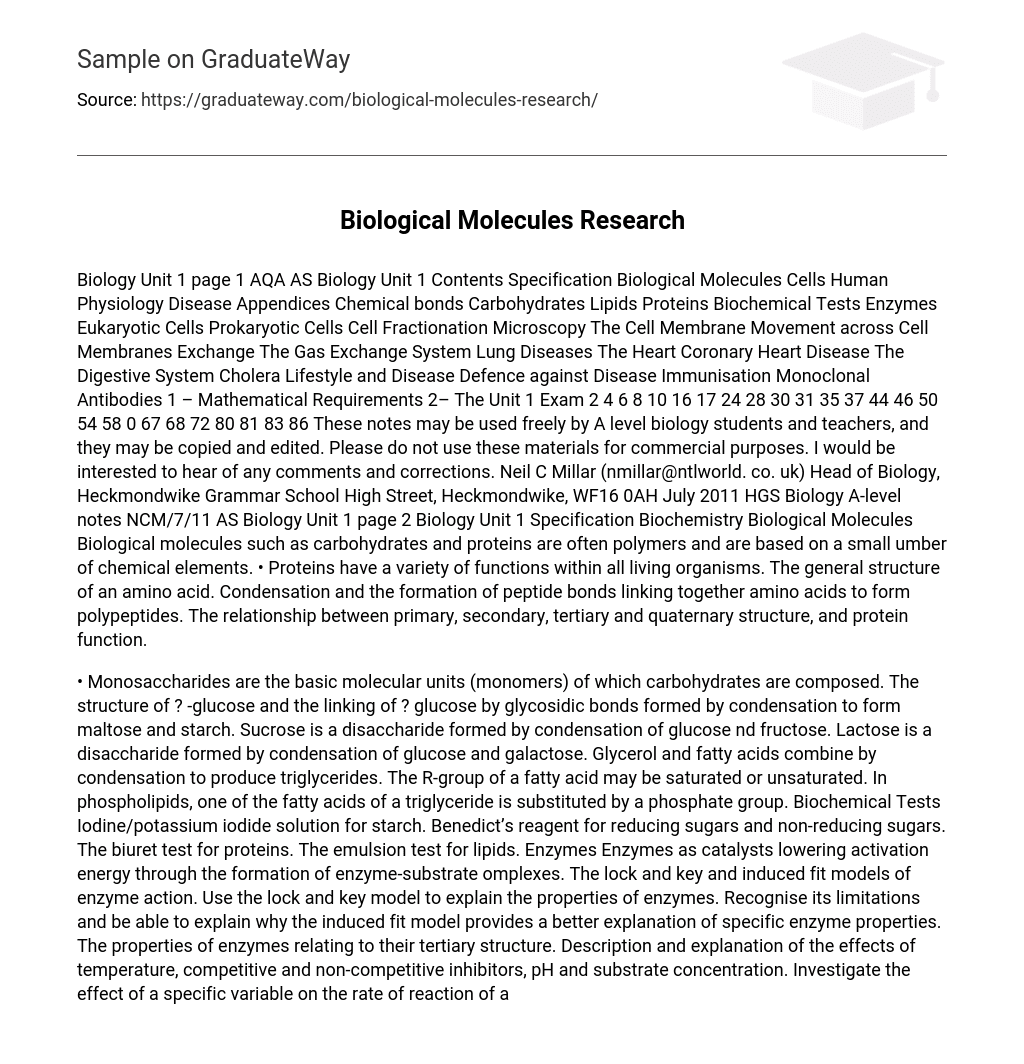Biological molecules such as carbohydrates and proteins are often polymers and are based on a small umber of chemical elements. Proteins have a variety of functions within all living organisms. The general structure of an amino acid. Condensation and the formation of peptide bonds linking together amino acids to form polypeptides. The relationship between primary, secondary, tertiary and quaternary structure, and protein function.
Monosaccharides are the basic molecular units (monomers) of which carbohydrates are composed. The structure of glucose and the linking of glucose by glycosidic bonds formed by condensation to form maltose and starch. Sucrose is a disaccharide formed by condensation of glucose nd fructose. Lactose is a disaccharide formed by condensation of glucose and galactose. Glycerol and fatty acids combine by condensation to produce triglycerides. The R-group of a fatty acid may be saturated or unsaturated.
In phospholipids, one of the fatty acids of a triglyceride is substituted by a phosphate group. Biochemical Tests Iodine/potassium iodide solution for starch. Benedict’s reagent for reducing sugars and non-reducing sugars. The biuret test for proteins. The emulsion test for lipids.
Enzymes as catalysts lowering activation energy through the formation of enzyme-substrate omplexes. The lock and key and induced fit models of enzyme action. Use the lock and key model to explain the properties of enzymes. Recognise its limitations and be able to explain why the induced fit model provides a better explanation of specific enzyme properties.
The properties of enzymes relating to their tertiary structure. Description and explanation of the effects of temperature, competitive and non-competitive inhibitors, pH and substrate concentration. Investigate the effect of a specific variable on the rate of reaction of an enzyme-controlled reaction. The appearance, ultrastructure and function of plasma membrane; microvilli; nucleus; mitochondria; lysosomes; ribosomes; endoplasmic reticulum and Golgi apparatus. Apply their knowledge of these features in explaining adaptations of other eukaryotic cells.
HGS Biology A-level notes The structure of prokaryotic cells to include cell wall, plasma membrane, capsule, circular DNA, flagella and plasmid. Microscopes and Cell Fractionation The difference between magnification and resolution. The principles and limitations of transmission and scanning electron microscopes. Principles of cell ractionation and ultracentrifugation as used to separate cell components.
The arrangement of phospholipids, proteins and carbohydrates in the fluid-mosaic model of membrane structure. Use the fluid mosaic model to explain appropriate properties of plasma membranes. The role of carrier proteins and protein channels in facilitated diffusion.
Osmosis is a special case of diffusion in which water moves from a solution of higher water potential to a solution of lower water potential through a partially permeable membrane. Investigate the effect of solute concentration on the rate of uptake f water by plant issue. The role of carrier proteins and the transfer of energy in the active transport of substances against a concentration gradient.
Diffusion is the passive movement of substances down a concentration gradient. Surface area, difference in concentration and the thickness of the exchange surface affect the rate of diffusion. The gross structure of the human gas exchange system limited to the alveoli, bronchioles, bronchi, trachea and lungs. The essential features of the alveolar epithelium as a surface over which gas exchange takes place. The exchange of gases in the lungs. The mechanism of breathing. Pulmonary ventilation as the product of tidal volume and ventilation rate.
The course of infection, symptoms and transmission of pulmonary tuberculosis. The effects of fibrosis, asthma and emphysema on lung function. Explain the symptoms of diseases and conditions affecting the lungs in terms of gas exchange and respiration. Interpret data relating to the effects of pollution and smoking on the incidence of lung disease. Analyse and interpret data associated with specific risk factors and the incidence of lung disease.





